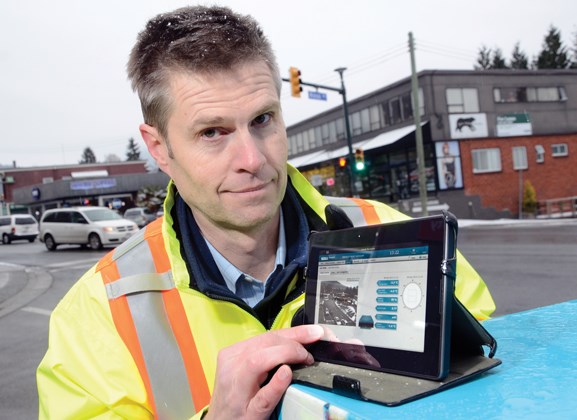The District of North Vancouver is hoping innovative technology will help combat some of its slick winter roads.
Road condition sensors, installed this year at the intersection of Ross Road and Mountain Highway in Lynn Valley, use infrared technology to measure road surface temperature, making snow and ice removal more efficient.
"We're one of the first to have this type of technology. We've been dealing with snow and ice for a number of years, obviously, and the problem we've had in the past as temperatures have fallen is we rely on weather forecasts to help us predict what's expected in terms of the cold weather," said Erik Bayfield, streets manager for the district. "What we've been finding though is that the air temperatures that the
meteorologists always give us are actually an unreliable way of telling us what's going to happen."
Bayfield said air temperatures often differ by a few degrees from the road surface temperature.
"Timing is everything. If we go too early, we waste the salt because what it does is it lands on dry road surface and is blown away by all the passing traffic (and) it ends up against the curb and goes down the drains," he said.
Bayfield said the sensors relay the road's surface temperature in real time, so crews can more accurately predict when the road is about to freeze, saving money in overtime costs and avoiding problems with inaccurate weather forecasts.
The sensors, installed on traffic signal poles, shoot infrared beams down onto the road and analyze the surface. Bayfield said it analyzes a number of different factors.
"It picks up the road's surface temperature and it also picks up the road's state," he said. "It sends that data back to us through a decision-making tool and. .. we actually get alerts as well, so we'll get alerted when the temperature of the road freezes and also if conditions change."
If it should suddenly start snowing during the night, said Bayfield, the sensors would alert first responders.
"There are a number of us that carry cellphones and so we will get alerted to our cellphone directly," said Bayfield. "So depending on who is on-call, that person will be able to very quickly jump into a snowplow and get to work clearing the streets."
Bayfield said this latest technology is an improvement over the previous road sensors that were embedded directly into the road's surface.
"These things were very unreliable and ultimately you would always have to tear them out because eventually you've got to come and re-pave the road or bury a water pipe or something," said Bayfield. "It was much more expensive to put these road sensors in the street, so they came up with this more non-invasive way of getting this data. Our number one priority is we want everyone to keep moving, all the traffic despite severe weather conditions but we want to do it in the most cost effective way possible."
The sensors cost $28,000 including the installation, data software and upkeep. Bayfield said the district estimates about $50,000 would be saved this year alone.
"We basically have paid for everything for the first two years and then the cost of running will be about $1,000 a year," said Bayfield, noting that the district will save on the cost of road salt. "We're already finding that we're using about 10 to 20 per cent less salt. By being able to delay our responses, essentially with this tool we're taking a lot of the guesswork out of what to expect with the changing weather."
The district is planning on installing the sensors at two more intersections next year, one in Upper Capilano and the other in Deep Cove. Bayfield said they chose Lynn Valley to start because it tends to be the first to get winter weather.
"It's a good barometer for us of what's happening in the district."



